15 Things You Never Knew About the Original 'Ghostbusters'
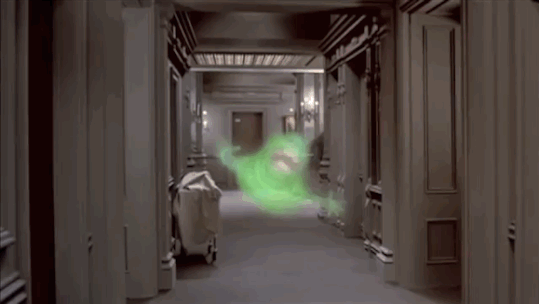
Slimer (a.k.a. Onionhead) vs. Bill Murray in ‘Ghostbusters’ (Columbia Pictures)
Editor’s note: The original version of this story ran on Oct. 26, 2015 to coincide with the release of the book Ghostbusters: The Ultimate Visual History. With this week’s launch of Paul Feig’s new Ghostbusters film, we thought it was worth revisiting.
_______________________
Imagine Eddie Murphy and his fellow paranormal firefighters battling a motorcycle-riding skeleton and a giant lizard monster from their gas-station base in a futuristic New Jersey. Who you gonna call? Ghost Smashers!
By the time it became an instant classic upon its release in 1984, Ghostbusters had morphed through radically different iterations, featuring bonkers plot points and unrecognizable creatures. Those mind-blowing details are chronicled by Ghostbusters: The Ultimate Visual History, author Daniel Wallace’s revelatory, self-explanatory new book.
“I’m a huge Ghostbusters fan, and pretty much every page in this book contains some sort of fact that either wowed me or gave me an acute case of nostalgia,” Wallace tells Yahoo Movies.
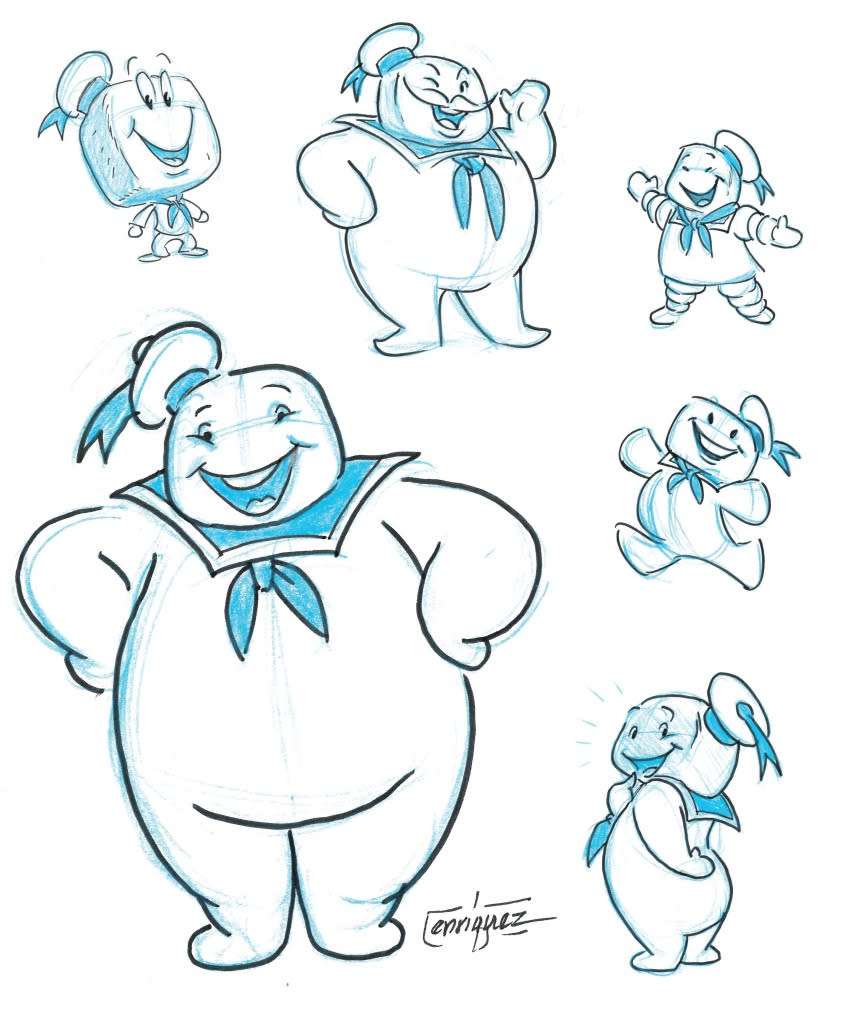
Thom Enriquez’s Mr. Stay Puft concepts (via ‘Ghostbusters: The Ultimate Visual History’)
Indeed, from star and co-writer Dan Aykroyd’s sci-fi-tinged original treatment and the casting process to concept art and deleted scenes, the new Ghostbusters tome is full of behind-the-scenes factoids that will astound even the movie’s biggest fans. Here are 15 to ponder:
1. Dan Aykroyd truly believes in ghosts
Aykroyd wrote Ghostbusters in part because he didn’t think it was right for skeptics to dismiss the paranormal. “What if you advertised on TV or in the Yellow Pages and said, ‘Hey, we believe you, we understand you’” the actor is quoted as saying in the book. “That was the birth of the commercial enterprise of ghostbusting.”
2. The original story was really out-there
Dan Aykroyd dreamed up his initial treatment for Ghostbusters around 1981 — the original title was Ghost Smashers. Per Wallace, the story “threw audiences into the deep end of the pool, with a near-future setting and innumerable procedural details concerning high-tech parapsychological tactics. The heroes operated out of a converted New Jersey gas station and faced spectral threats, including a skeletal biker who terrorized a small town.” In the climax, “the Ghostbusters traveled to alternate dimensions.” As director Ivan Reitman relates in the book’s introduction, he received an updated outline in 1983 featuring “a group of men, acting much like firefighters, [who] would trap and catch ghosts as part of a new protective emergency service for the universe at large.” Reitman suggested that Aykroyd reconceive “the story in modern-day Manhattan and frame the adventure as a 'going into business’ tale.” He also encouraged Aykroyd to bring in Harold Ramis as a co-writer. The brain trust was set and together over a two-and-a-half week vacation with their families in Martha’s Vineyard, the trio reshaped the story.
3. The many Peter Venkmen
The script was written for Aykroyd’s fellow Blues Brother John Belushi to play Peter Venkman, but Belushi died of an overdose in 1982. Aykroyd then zeroed in on Eddie Murphy to co-star. At one point another Saturday Night Live colleague, Chevy Chase, was eyed for the role — the book includes an excerpt of a script that mentions a “female ghost (romantic-sexy) [that] seduces Chevy Chase.” (Bill Murray, of course, ultimately came aboard.) Chase, meanwhile, cameoed in Ray Parker Jr.’s “Ghostbusters” music video.

Chevy Chase in Ray Parker Jr.’s ‘Ghosbusters’ music video (Arista Records)
4. A veritable who’s-who of stars were considered for the cast
While the new book doesn’t dive into all the name-brand actors in contention for various roles (like Michael Keaton as Venkman; Paul Reubens as the demon Gozer; or Christopher Walken, Christopher Lloyd, Jeff Goldblum, and John Lithgow as Egon Spengler), Reitman does mention that he considered Grace Jones as Gozer (eventually played by Yugoslavian model Slavitza Jovan). Sandra Bernhardt was considered for the role of secretary Janine Melnitz, which went to Annie Potts. And John Candy had been tapped for the role of accountant Louis Tully. “It was a different kind of character, much more flamboyant, more the character John played on SCTV [Johnny LaRue],” explains Ghostbusters producer Joe Medjuck in the book. "I think he just didn’t want to play it again, but he also had some strange ideas that Ivan didn’t want to deal with.“ Reitman balked at Candy wanting the character to have a German accent and a pair of Rottweilers as pets. So they brought in another SCTV alum, Rick Moranis, who rewrote the part. But, like Chase, Candy resurfaced for the "Ghostbusters” video.
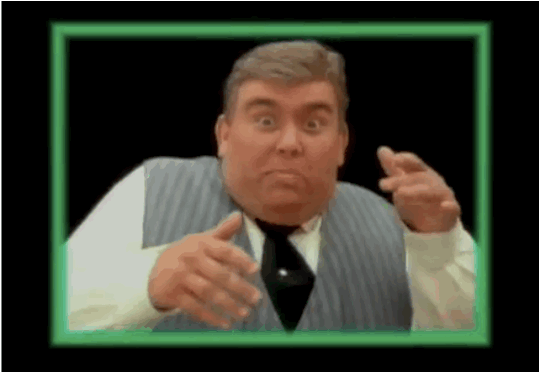
John Candy in Ray Parker Jr.’s ‘Ghosbusters’ music video (Arista Records)
5. Stay-Puft wasn’t always the big bad
While many of the original elements of Aykroyd’s spacey early treatments were jettisoned, several key pieces remained. Among them: there would be a core team who operated like spook-battling firefighters, and they would encounter an apparition with a voracious appetite as well as a monstrous Stay Puft marshallow man. However, as shown in early concepts sketched by production artist Thom Enriquez (who came up with the looks for many of the film’s signature creatures), at least one version envisioned Ray’s pet lizard being transformed into a Godzilla-sized creature for the climactic attack on New York City — a tidbit Wallace cites as one of the most surprising things he discovered during his research.

Thom Enriquez’s sketch for ginormous version of Ray’s pet lizard, supersized for a NYC attack (via ‘Ghostbusters: The Ultimate Visual History’)
Enriquez also went through several versions of the “Terror Dog” incarnations of the demons otherwise known as Zuul (the Gatekeeper) and Vinz Clortho (the Keymaster), which possess Sigourney Weaver and Rick Moranis.

Thom Enriquez’s Terror Dog concepts (via ‘Ghostbusters: The Ultimate Visual History’)
6. Inside the marshmallow man
Mr. Stay Puft was a cross between the Michelin Man and Pillsbury Doughboy, according to Aykroyd. Like the old Godzilla movies, the “real” Stay Puft was a guy in a (fireproof) suit wreaking havoc on a scale-model Manhattan populated by toy cars. Filmmakers executed the stream-crossing incineration sequence as a practical effect in one take.

Can you say s’mores? Mr. Stay Puft meets his fiery doom (via ‘Ghostbusters: The Ultimate Visual History’)
For the big explosion at the end, gallons of shaving cream were dumped over the actors and set elements to simulate the marshmallow remains.
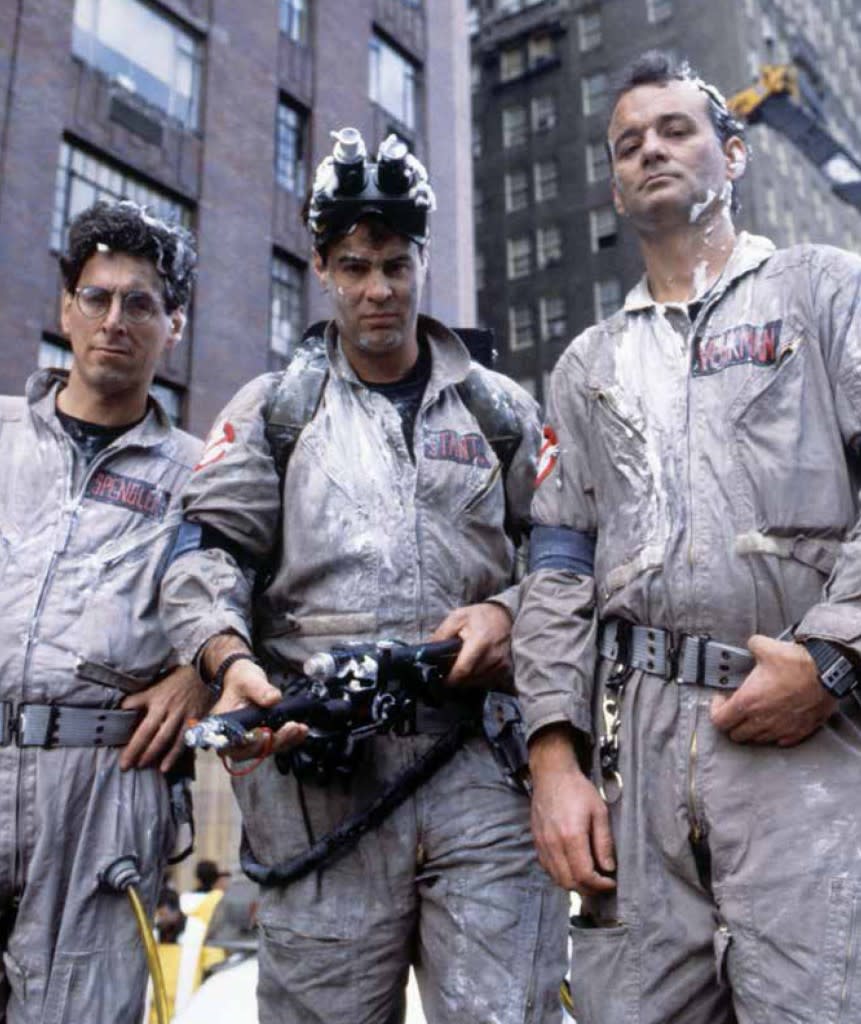
Ramis, Aykroyd, and Murray covered in Stay Puft’s remains (via ‘Ghostbusters: The Ultimate Visual History’)
7. Slimer who?
Aside from Mr. Stay Puft, the movie’s most memorable ghost was Slimer, the greenish glutton plaguing the fictional Sedgewick Hotel. The ghost was only known on set as “Onionhead,” because of the stench that was its main characteristic in early drafts of the script and was never named in the film.

Onionhead/Slimer storyboard detail (via Flickr)
However, once Murray’s Venkman announces, “He slimed me,” the ghoul was henceforth known as Slimer by fans, and the name stuck in Ghostbusters spinoffs and merchandise.
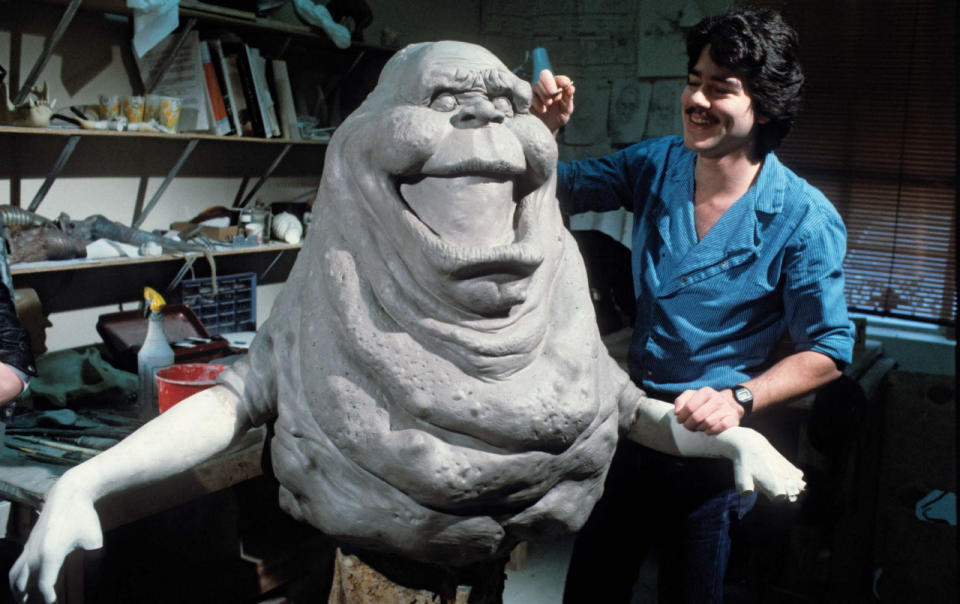
Steve Johnson sculpts full-size Onionhead/Slimer (via ‘Ghostbusters: The Ultimate Visual History’)
8. Improv led to some of the most memorable lines
Because most of the cast came up through the ranks in sketch troupes like Second City and shows like SNL and SCTV, there was lots of ad-libbing. After capturing Slimer in the hotel, “the door would sling open and we never knew what Bill was gonna say,” recounts Medjuck. “He did about 10 things, and I’d say seven of them were great.” Reitman went with the now-classic Murray line: “We came, we saw, we kicked its ass.”
9. How they did those spooktacular effects
The first spook the team encounters, the Library Ghost, was another practical effect. Actress Ruth Oliver played the human form; the scary version was played by a puppet.

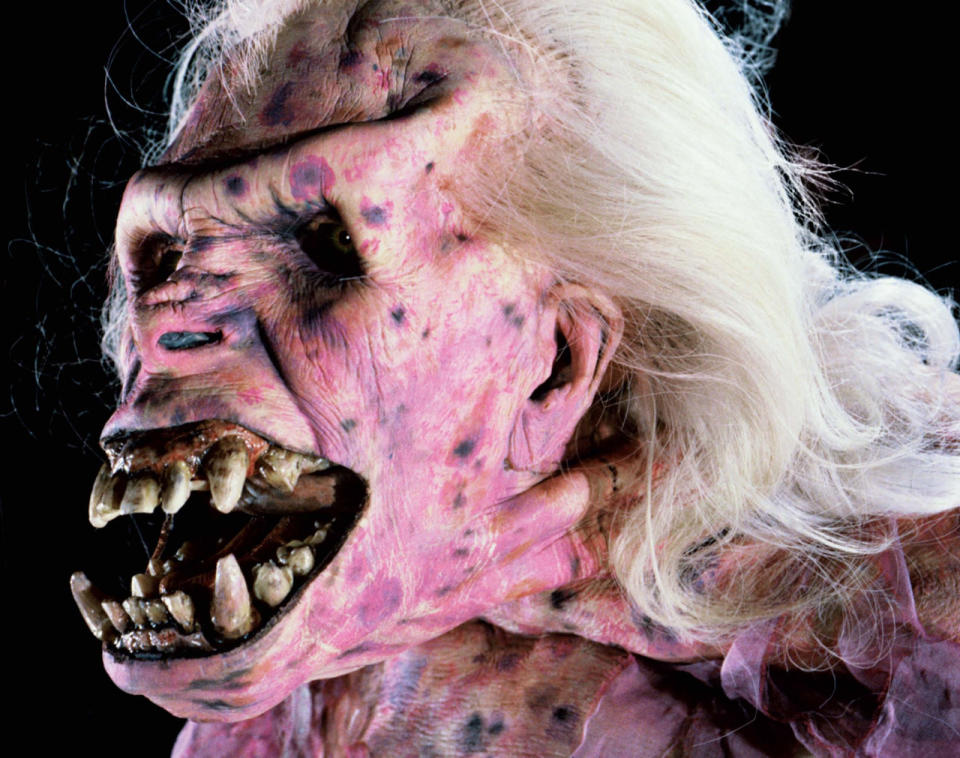
Library Ghost concepts and close-up of puppet (via ‘Ghostbusters: The Ultimate Visual History’)
While the exteriors were filmed at the New York Public Library, the main interior shots were done at the Los Angeles Public Library, while the actual ghostly transformation was done on a soundstage.
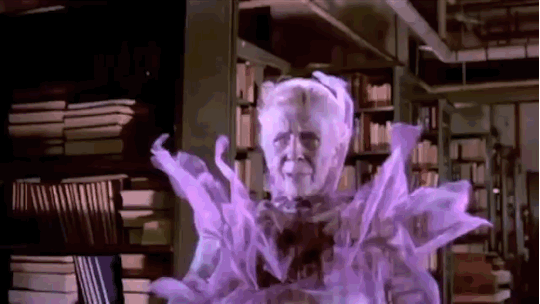
Library Ghost transforms (Columbia Pictures)
10. Location, location, location
Reitman spent nearly a month in New York shooting on location. Aside from the library, key sites includes Lincoln Center, Columbus Circle, the old Tavern on the Green restaurant, and Central Park West (creating a massive traffic jam which author Isaac Asimov told Aykroyd was “disgusting”). Also used: Columbia University, which agreed to permit shooting as long as the school was not identified by name (“now they sort of brag about it,” notes Medjuck).
11. The deleted subplot
While shooting in Central Park, Reitman filmed footage of Murray and Aykroyd playing two homeless guys who acted as a something of a Greek chorus (or, in Ramis’s words, "Shakespearean fools or gravediggers”), popping up throughout the movie providing “absurd commentary” on what was happening. But Reitman eventually decided the actors weren’t disguised enough and that their presence might confuse the audience. The storyline was cut out.
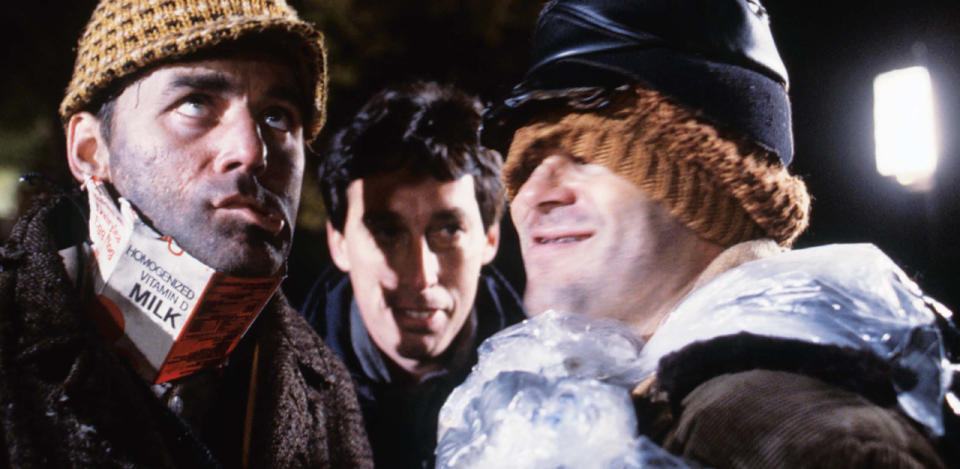
Rare shot of deleted scene of Bill Murray and Dan Aykroyd in character as homeless men with Ivan Reitman behind them (via ‘Ghostbusters: The Ultimate Visual History’)
12. Inside the Ecto-1
The Ecto-1, or Ectomobile, was originally a pink 1958 Cadillac Miller-Meteor ambulance rescued from a salvage yard before being tricked out for the movie. The car was painted jet black until cinematographer László Kovács broke it to the design team that the vehicle would appear nearly invisible on camera during night shoots. But what most fans don’t know, per Wallace: “At one point, the Ectomobile was alive and had a mind of its own.” One scene, cut from the film, hinted that the car had its own supernatural powers by lashing out at a policeman over a parking ticket using telekinesis.
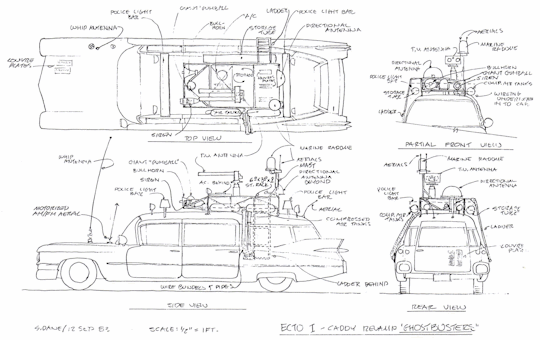
Stephen Dane’s design notes on the Ecto-1 (via ‘Ghostbusters: The Ultimate Visual History’)
13. So that’s what those tubes were for…
The coveralls worn by the Ghostbusters remained largely unchanged from Aykroyd’s original treatment, where they “were described as very simple, like a garbage man,” Reitman explains in the book. “But it was [Oscar-winning costumer Theoni Aldredge’s] detailing that made them stand out… It was a blue-collar job and they dressed in a blue-collar way.” And, according to Aykroyd, everything on the jumpsuits served a purpose. As he explains in his foreword, those clear plastic hoses were “for incontinence due to fear.” Now you know.

We finally know what those clear hoses were for (Columbia Pictures)
14. Ghost-whatsers?
Aykroyd’s original title was Ghost Smashers, which soon became Ghost Chasers. Eventually, he, Ramis, and Reitman settled on Ghostbusters. But Columbia Pictures was worried about securing the name rights — there was a 1970s live-action kiddie show called The Ghost Busters — and so the studio came up with contingency titles that included Ghoststoppers and Ghostblasters. But once Reitman shot the scene with the crowd chanting “Ghostbusters!”, the studio ponied up for the title rights. (Medjuck says he called Columbia executives during filming and held up the phone so the suits could hear the enthusiastic extras screaming.)
‘The Ghost Busters’ intro (via YouTube)
15. Life beyond the movie
Merchandising really took off with the 1986 cartoon The Real Ghostbusters, which ran for seven seasons and led to a Kenner toy line and Marvel comic book. While the series used music and character names from the movie, the cast was purposely drawn to not resemble the actors to avoid having to pay “likeness rights.” But that wasn’t the only change. “The Real Ghostbusters was hit hard by 1980s standards and practices for children’s television,” Wallace tells Yahoo, “and Ghostbuster secretary Janine Melnitz was forcibly redesigned with a softer and more 'motherly’ look.”
‘The Real Ghostbusters’ intro (via YouTube)
One of Wallace’s takeaways from writing his book is that the 1984 film was the launching point for something much bigger.
“Ghostbusters isn’t just a classic film and a fun sequel — it’s a whole franchise,” the author says. “A generation of kids grew up with the TV cartoon The Real Ghostbusters and all the action figures and Happy Meal toys and there’s a whole universe beyond that.
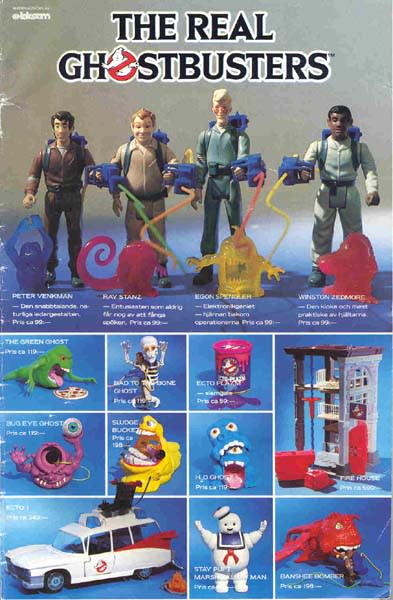
Kenner’s ‘Real Ghostbusters’ toys (via GBFans.com)
“The book covers video games, comic books, the limited-edition art poster scene, even the 1990s cartoon Extreme Ghostbusters. I think the lesson is that Ghostbusters, as a setting, has such a cool world-building hook: What if ghosts were real, and they were actually so annoying that you’d have to call an exterminator?”
Sony, which owns Columbia Pictures, Reitman, and Aykroyd are attempting to continue that world-building by producing Paul Feig’s female-centric Ghostbusters, starring Kristen Wiig, Melissa McCarthy, Kate McKinnon, and Leslie Jones, and due in theaters Friday. The reboot will feature appearances by much of the original cast.

Leslie Jones, Melissa McCarthy, Kristen Wiig, and Kate McKinnon in new ‘Ghostbusters’ (Sony Pictures)
“I’m definitely looking forward to it,” says Wallace. “One of the things that I learned while writing the book is that the Ghostbusters don’t have to be Peter, Ray, Egon, and Winston. When fans dress up as Ghostbusters at Comic-Con, they put their own names on the jumpsuits, not Venkman’s name. So it’s a very egalitarian idea, that anybody can become a Ghostbuster. I think the idea of a whole new crew is great and doesn’t take anything away from the original.”
Ghostbusters: The Ultimate Visual History is available on Amazon ($35).
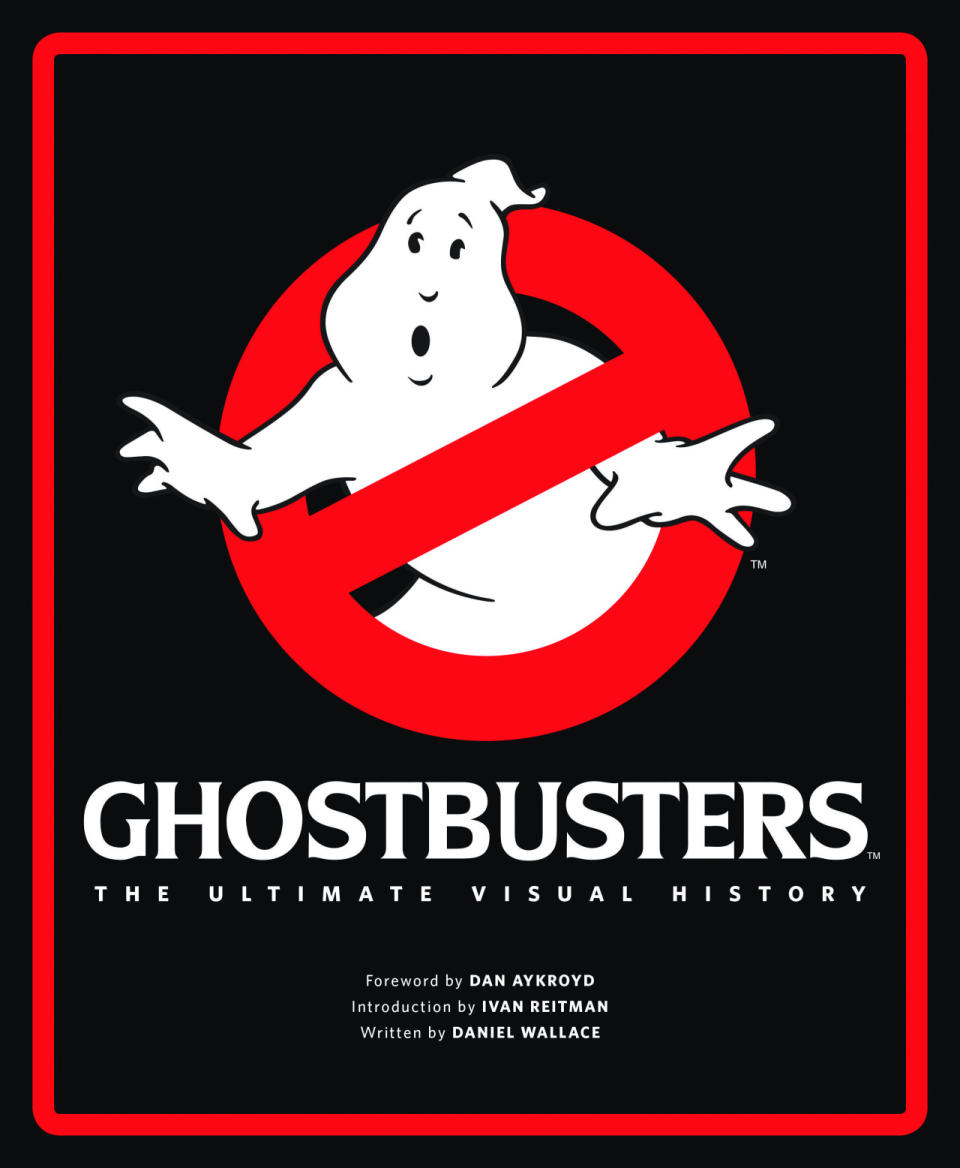
Ghostbusters TM and ? 2015 Columbia Pictures Industries, Inc. All rights reserved. Unless otherwise noted, images excerpted from Ghostbusters: The Ultimate Visual History by Daniel Wallace. Used with permission of Insight Editions.

